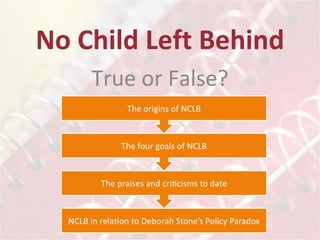Introduction to the No Child Left Behind Policy
•Descargar como PPT, PDF•
1 recomendación•1,479 vistas
This is presentation serves as an introduction to the No Child Left Behind policy. It was created for my Honors Public Policy class at the State University of New York at Albany.
Denunciar
Compartir
Denunciar
Compartir

Recomendados
Más contenido relacionado
La actualidad más candente
La actualidad más candente (20)
Current Issues in Curriculum Development in the Philippines

Current Issues in Curriculum Development in the Philippines
Aims, goals and objective purpose in curriculum development

Aims, goals and objective purpose in curriculum development
Curriculum change/ Curriculum Change Process / Issues in Curriculum Change 

Curriculum change/ Curriculum Change Process / Issues in Curriculum Change
Basic Education Reforms and the K to 12 Program in the Philippines

Basic Education Reforms and the K to 12 Program in the Philippines
Destacado
Destacado (6)
Education Policy- No Child Left Behind and the Every Student Succeeds Act

Education Policy- No Child Left Behind and the Every Student Succeeds Act
Similar a Introduction to the No Child Left Behind Policy
Similar a Introduction to the No Child Left Behind Policy (20)
20130718 Alger Time to Retire, Not Reauthorize, No Child Left Behind

20130718 Alger Time to Retire, Not Reauthorize, No Child Left Behind
1Ethics in Assessment No Child Left Behind Act ht.docx

1Ethics in Assessment No Child Left Behind Act ht.docx
Please respond to the following discussion questions, discussion res.docx

Please respond to the following discussion questions, discussion res.docx
Citation (APA) Greenlee, B. J. (2007). When school advisory co.docx

Citation (APA) Greenlee, B. J. (2007). When school advisory co.docx
4 Reasons for Public School Districts to Invest in Local Research - SchoolWea...

4 Reasons for Public School Districts to Invest in Local Research - SchoolWea...
Educational Stability for Children and Youth in Foster Care

Educational Stability for Children and Youth in Foster Care
Introduction to the No Child Left Behind Policy
- 1. No Child Left Behind True or False?
- 4. The Second Goal increased flexibility as to where federal funds can be allocated within the school district
- 5. The Third Goal the three initiatives
Notas del editor
- ESEA was created in 1965 in conjunction with LBJs war on poverty, this was originally only authorized for 5 years, but has been reauthorized every five years ever since Title 1 was created under this act which targeted funding in schools that were comprised of more than 40% poverty stricken students , and some money from NCLB still goes to this today 35 years later however, the education system was not much improved and was under attack during the 2000 election where governor Bush ran on a campaign that stressed leaving no child left behind, stressing that there was a large gap between affluent students and poor students Then after announcing his plans for the No Child Left Behind Act just three days after his inauguration, it was signed into law in 2002
- School districts are also expected to meet a proficiency level in all subgroup categories including, income, race and ethnicity, disability, and those who are limited English proficient After two years of being considered a failing school, students have the option to receive tutoring or be transferred to another school deemed as passing, which is intended to be funded by the district After five years of being considered a failing school, a school becomes subject to “reconstruction” under NCLB which requires the district to chose at least one of four options for restructuring the school. These four options include reopening the school as a charter school, replacing all or most of the staff, entering into a contract with a private management company, or turning the operation of the school over to the state.
- Under No Child Left Behind, four essential programs were created that are required to be put in place within all school districts However, a district is allowed to decide where up to 50% of the federal funds can be allocated depending on their particular district’s needs in an attempt to cater to the specific needs of districts This aspect of the law is designed to transfer decision-making power from the federal government to the states and local districts.
- According to The National Assessment for Educational Progress aka “The Nation’s Report Card” test scores have improved in specific subjects among certain subgroups Ex. Closing the achievement gap
- Further, many question why in an underfunded situation President Bush only requested a little over half of the allotted money he could have for several of the acts initiatives. In addition many criticize the fact that funds are subtracted when a district fails to meet standards as these funds could be considered essential in improving the school While federal funds only comprises 8% of a school district’s budget, with the new trend of failing district budgets, and an increased number of cuts being made at the state level, federal funding is critical ----------------------------------- Many fear that teaching towards the test will diminish the ability of humans to think analytically, and rather simply learn a small set of skills that will enable them to pass a standardized test. Science, the arts, and social studies are being put by the waist side
- One of the biggest themes in Policy Paradox is the issue of Ambiguity which can be directly applied to NCLB in that Initially NCLB received an overwhelming amount of bipartisan support but the law soon fell under great scrutiny causing politicians to have to sort through an overwhelming amount of uncertain issues that can go in a number of different directions with no clear solution
- In what fair way can it be measured? --ex. An example of this is do standardized tests provide an accurate means of measuring whether a student is proficient?